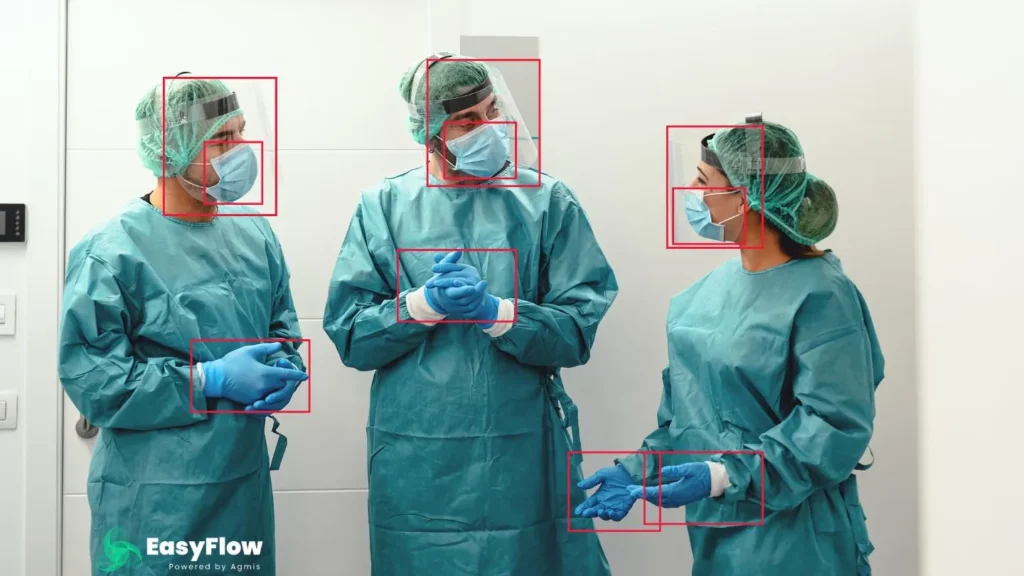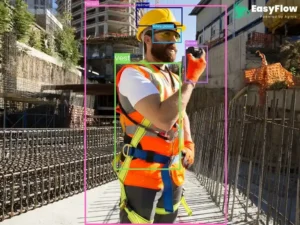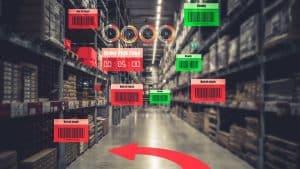AI-powered solutions are changing how we use personal protective equipment (PPE) in healthcare. These smart systems help make sure masks, eye protection, gowns, and gloves are worn correctly.
They use video cameras to check in real-time and can alert staff if something is wrong. They also create reports to help safety managers keep track of everything. These AI systems can fit into the current camera systems without much hassle. They use smart predictions to spot problems before they happen and give feedback to improve future PPE use. They also help with training, making infection control better and workers more confident.
Learn more about how AI is making healthcare safer.
Understanding Droplet Precautions
Droplet precautions are important rules to stop the spread of illnesses that travel through tiny drops in the air, like the flu, COVID-19, and whooping cough. These rules are very important in places like hospitals to keep both patients and healthcare workers safe from germs.
One big part of droplet precautions is using personal protective equipment (PPE). This includes things like surgical masks, eye protection, gowns, and gloves. PPE helps block the germs from spreading through the air.
Healthcare workers need to know how to properly put on, take off, and throw away PPE. This training is important to prevent them from getting contaminated and to make sure the PPE works well. Following these rules is not just a good idea; it is also required for safety in healthcare settings.
The safety rules also say that people should stay at least six feet away from those who are sick and that sick patients should stay in their own rooms. It’s also important to limit how much these patients move around outside their rooms. Following these steps keeps everyone safer.
Current Challenges in PPE Compliance
Personal protective equipment (PPE) is very important for stopping the spread of germs. But many healthcare workers have trouble using it correctly. One big problem is that they don’t always know what PPE to use for different diseases. This can lead to mistakes when putting on or taking off PPE, which can spread germs up to 70% more.
Not using PPE properly causes about 20% of infections that happen in hospitals. This shows how important it is to follow PPE rules. But this is hard because workers don’t get enough training and reminders. About 30% of healthcare workers say they don’t feel sure about their PPE skills, so regular training is needed.
Another problem is that PPE can be uncomfortable to wear. More than 40% of healthcare workers say they don’t wear PPE all the time because it’s not comfortable. This can be because of how the equipment is made or how long they have to wear it.
Healthcare settings are also busy and stressful, which can lead to forgetting PPE. Workers have to make quick decisions, and using PPE the right way can be missed. Fixing these problems is really important to keep both healthcare workers and patients safe.
How AI Enhances PPE Detection and Compliance
AI technology helps make sure that healthcare workers wear the right protective gear, like masks and gowns, by using smart computer programs to watch real-time video feeds. These advanced systems can quickly spot if someone is missing or not wearing their PPE correctly and alert safety managers to fix the problem right away. This real-time checking helps keep everyone safe by lowering the chances of spreading germs.
Making sure PPE is worn correctly is very important, especially during outbreaks of illnesses that spread through droplets. With AI, hospitals and clinics can make sure their staff always follow the rules for wearing protective gear. The technology doesn’t just find mistakes; it also collects important information for safety checks. These checks are easier with AI because it creates automatic reports, showing areas that need attention and helping meet safety standards.
AI can also look at past data to find patterns in how PPE is used. This helps improve safety rules and fix ongoing problems. By using AI, healthcare settings can do better safety checks, leading to a safer place for both workers and patients.
Using AI for PPE detection means taking a proactive approach to safety, ensuring that the right gear is always worn. The continuous feedback from AI not only makes PPE rules more effective but also creates a culture of ongoing improvement and careful attention to safety in healthcare.
Integration of AI with Existing Systems
Adding AI to existing surveillance systems helps healthcare facilities monitor PPE use without disrupting their daily work. AI can easily fit into the current setup and make it much better at spotting if healthcare workers are wearing the right personal protective equipment (PPE) for droplet precautions. This is important for real-time checks, making sure any issues with PPE use are caught immediately.
AI can look at video feeds to see if healthcare workers have on the necessary PPE, like surgical masks and eye protection. If someone is not wearing their PPE correctly or at all, the system can quickly send out alerts. This helps keep everyone following safety rules, which is key for reducing the risk of spreading diseases.
Adding AI to these systems usually needs only small changes, so healthcare work can go on without interruptions. This way, workers can keep focusing on their main jobs without needing a lot of extra training.
Also, the data collected by these AI systems can help improve future training and policies. By looking at how PPE is used over time, healthcare facilities can come up with better ways to control infections, making sure that PPE is used properly and efficiently.
Predictive Analytics for Proactive Safety Management
How can predictive analytics improve safety in healthcare? Predictive analytics is a smart way to make healthcare safer, especially when it comes to using protective gear to stop the spread of germs. By looking at past data on how well people follow safety rules, predictive analytics can spot times when they might not follow the rules in the future. This helps healthcare facilities fix problems before they happen, keeping everyone safe and preventing the spread of diseases.
Machine learning, a type of computer technology, is important for this improvement. It uses real-time data from protective gear usage and incident reports to predict risky situations. For example, if the data shows that certain shifts might run out of protective gear, healthcare managers can make sure there are enough supplies.
Predictive analytics also looks at things like workplace conditions and employee behavior to understand what protective gear is needed in different situations. This helps keep healthcare workers safe during risky tasks.
Using predictive analytics in safety management also lowers the chances of infections spreading through droplets. By making sure protective gear is used correctly and on time, healthcare facilities create a safer place for both patients and staff. Plus, data-driven insights help develop better training programs, making sure all employees know how to follow safety rules properly.
Training and Education
Learning how to use protective gear (PPE) is very important for keeping healthcare workers and patients safe from diseases. Training on PPE, like masks, eye protection, gowns, and gloves, helps stop the spread of illnesses like the flu and COVID-19.
Workers need to know how to put on (don) and take off (doff) PPE correctly to avoid getting germs on themselves. They must also wash their hands with soap, which is a key part of staying clean and safe.
It’s important to keep training workers regularly, especially when there are new rules. This helps them remember what to do and stay careful. Talking to workers about using PPE and listening to their ideas can make everyone better at keeping safe.
Using practice sessions and showing workers how to use PPE can make them feel more confident and skilled. These practice times let workers try out what they learn in a safe place, so they are ready for real patient care.
Challenges and Considerations in AI Implementation
Implementing AI solutions for PPE (Personal Protective Equipment) detection comes with some challenges. These include ensuring high accuracy in different real-world conditions and keeping data private and secure. Changes in lighting, worker movements, and the busy nature of healthcare settings can affect how well the AI detects PPE. AI systems must consider these factors to make sure PPE is used properly and safety rules are followed.
One major challenge is fitting AI systems into existing safety rules. This needs careful planning and training so healthcare staff know how to use the new technology. This might disrupt their usual work at first. Some employees might also resist using new technology. It’s important to create a positive safety culture that supports new ideas and keeps everyone involved.
Protecting data privacy and security is crucial when using AI systems. Organizations must follow strict rules on how they collect, store, and use video footage and other sensitive data. Following these rules is important to maintain trust and avoid legal issues.
Continuous monitoring and making improvements based on real-time data are key to enhancing AI system performance. By tackling these challenges, AI solutions can help ensure PPE compliance and create a safer healthcare environment.
| Challenge | Description | Solution |
|---|---|---|
| Accuracy in Real-world | Changes in lighting and movement affecting detection rates | Use diverse training data and adaptable algorithms |
| Data Privacy | Following rules on data collection and storage | Use strong encryption and follow legal standards |
| Workflow Integration | Disruption of usual workflows and resistance from employees | Provide detailed training and promote a positive safety culture |
| Continuous Improvement | Need for ongoing monitoring and updates based on real-time data | Use feedback loops and keep refining AI systems |
Overcoming these challenges is essential for successfully implementing AI in PPE detection, which will improve safety and compliance in healthcare settings.
Future Directions for AI in PPE Compliance
The future of AI (Artificial Intelligence) in PPE (Personal Protective Equipment) compliance is very exciting. AI can use smart tools to predict safety risks and help keep workers safe before accidents happen. This means fewer injuries at work because companies can fix problems before they become serious.
AI can also learn from past data to provide better safety solutions for different workplaces and employee habits. This means safety rules can change and improve over time to handle new risks. AI can also make safety checks faster and easier. Instead of doing manual checks, AI can automate these processes, saving up to 50% of the time and resources. This allows safety officers to work on more important safety projects.
With the help of advanced computer vision and machine learning, AI can become very good at spotting if workers are wearing their PPE correctly. AI can now identify proper gear usage with over 95% accuracy. This ensures that safety rules are followed strictly, protecting employees in various work conditions. By using these technologies, companies can improve PPE compliance and create a strong culture of safety.
Conclusion
AI-powered solutions can really help improve the use of personal protective equipment (PPE) in healthcare settings. These technologies make it easier to predict needs, monitor compliance in real-time, and provide targeted training. This greatly enhances infection control and safety. When AI is combined with existing systems and proactive safety strategies, it supports the effective use of PPE. Continued advancements and thoughtful use of AI are essential in reducing the spread of infectious diseases and protecting healthcare workers and patients.
Not Sure How AI Can Help Your Business? Let’s Talk!

Lukas Vaznelis
Business Development Manager
Book a no-obligation free consultation with our expert.



